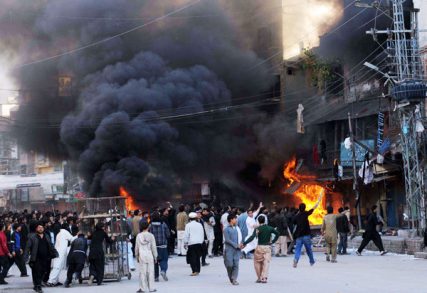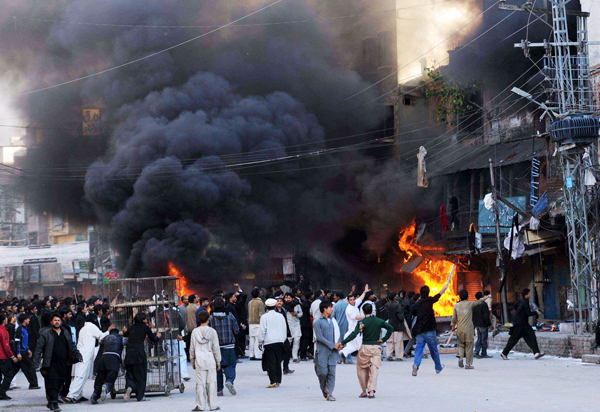RAWALPINDI, Pakistan (RNS) Qadeer Abbasi is recovering from a broken arm in his two-room shanty home not far from the capital, Islamabad.

Participating in a procession mourning deaths of Prophet Mohammad’s grandchildren, Shiites torch a market in Sunni-dominated Rawalpindi, a garrison city adjacent to Pakistan’s capital Islamabad, on November 15, 2013. Photo by Naveed Ahmad
On Nov. 15, Abbasi, 34, offered noontime Friday prayers at Madrassa Taleem ul Quran when the seminary was attacked by a procession of Shiite mourners. Besides the Sunni madrassa, the Shiites also struck 100 shops, four private banks and scores of cars.
In less than an hour, 12 people were killed and intense gunfire prevented humanitarian services from ferrying the injured to hospitals.
Reports suggest some of the Sunnis praying at the madrassa insulted the Shiites as they passed during the annual procession for Ashura. But Abassi said he heard nothing until gunfire rang out.
All of Islam’s sects revere Ashura, the day the Prophet Muhammad’s maternal grandson Hussein and his family were slaughtered and starved to death in Karbala (a city in today’s Iraq). But Shiites have traditionally staged elaborate rituals to mark what they deem the worst tragedy of Muslim history.
Each year during Ashura, which falls on the 10th of Muharram according to the Islamic calendar, people are killed in Pakistan. But tit-for-tat target killings between Sunnis and Shiites have escalated this past year, with Taliban forces repeatedly targeting Shiite processions and places of worship and Iran-backed Shiite groups retaliating.
Home to 188 million people, 95 percent of Pakistan’s population is Muslim and they are predominantly Sunni. Only 13 percent of its citizens are Shiite.
Abbasi, who sells popcorn on a pushcart, believes his life changed forever after the attack.
“I sleep in fear of being burnt alive as the image of carnage revisits me every night,” he said, speaking from his small home on the bank of a draining canal that crisscrosses this British-era garrison city.
Three months later, there are few efforts of reconciliation afoot in Rawalpindi.
“The religious leaders hold the key to peace here,” said Sheikh Rashid Ahmad, a popular politician who helped ease the tensions after the carnage. “They must come forward to root out sect-based hatred and violence.”
Over the past two decades, the Shiite minority has attained top positions in media, bureaucracy and politics.
“Whosoever reaches power corridors or top offices aims at self-preservation,” said Aoun Naqvi, a schoolteacher who practices Shiite Islam.
Pakistan inherited Sunni-Shiite animosity from India, which Muslims ruled from 712 to 1857. With the creation of Pakistan, Shiites from various cities in India migrated to Pakistan in large numbers and settled in cities such as Karachi, Hyderabad and Multan.
In modern-day Pakistan, Sunni-Shiite harmony was dealt a hard blow with the fall of the Shah of Iran. Not only did Pakistan lose its land route to Europe, but Tehran also became hostile to Islamabad for its pro-U.S. policies.
However, roots of recent sectarianism can be traced back to 1990, when a leading Sunni cleric Maulana Haq Nawaz Jhangvi was assassinated by suspected Shiite militants.
Jhangvi was a fierce anti-Shiite campaigner. Following the 1979 Iranian revolution, Shiites mobilized their community through an outfit known as Tehreek-e-Nifaz-e-Fiqh-e-Jafria (Movement for Imposition of Shiite jurisprudence) in Bhakkar.
The 1990s was an era of tit-for-tat Shiite and Sunni killings.
“With nuclear sanctions likely to be eased in Iran, and NATO forces withdrawing from Afghanistan, both Iran and Saudi Arabia will use their proxies to wrestle for influence over Pakistan,” said Habib Ahmad, who teaches economics in Multan. He was referring to the interim deal struck in November between Iran and six global powers, under which Tehran agreed to scale back uranium enrichment in return for sanctions relief.
Meanwhile, the violence continues. In mid-January, a Sunni leader was gunned down at his home in the Punjab province. The same day another Sunni cleric was injured in southern metropolis of Karachi.
Within the next 24 hours, two dozen people including women, children and security personnel were killed when a bomb blew up a bus of Shiite pilgrims returning from Iran, in the southwestern province of Balochistan.
In Quetta, the capital of Balochistan province, Shiites refused to bury the blast victims until the killers are arrested and stern charges leveled.
Neither Shiite nor Sunni leaders speak candidly about the renewed spree of sectarian violence. Both offer the same explanation: “External forces are pitching Muslims against Muslims.”
Abbasi is not convinced. “Though Shiites wanted to kill me that Friday, I don’t identify myself as a Sunni,” he said. “I am only a Muslim who believes in peace and co-existence.”
(Naveed Ahmad is a freelance journalist based in Pakistan and Turkey. Follow him on Twitter @naveed360.)
YS/AMB END AHMAD





